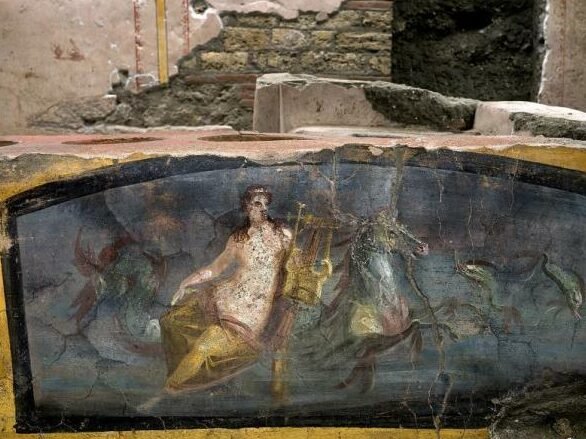December 28. According to a report by the “Central News Agency”, the archaeological team recently discovered an unusually intact “food stall” decorated with brightly painted murals in Pompeii, Italy, to provide people with an understanding of the life in Pompeii. More clues.
On December 26, 2020, local time, Italy, the ruins of a well-preserved fast-food restaurant unearthed in the ancient city of Pompeii, Italy, the murals on the counter are still brightly colored after thousands of years. Picture source: IC photo
According to reports, the world-famous ancient Italian city of Pompeii is located near Naples. In 79 AD, when Mount Vesuvius erupted, the entire city of Pompeii was buried in ash and lava.
Archaeologists have continued to excavate the remains of Pompeii in recent years. The recently discovered thermopolia is located at the intersection of the busy Silver Wedding Street and Balcony Lane. There are round holes on the counter as places for food pots. It can be regarded as the “food stall” of this period.
For nearly 2,000 years, it was hidden under thick volcanic ash. It was not until part of the site was unearthed in 2019, and archaeologists continued to excavate. It was only able to see the sky again and give a glimpse of the glory of the past.
The latest stage of the work found that the murals were painted with many scenes of life at that time, and the pictures of animals such as chickens and ducks should be the menu items provided by the “food stall”.
With these murals, scientists can get a glimpse of the lives of the residents of Pompeii and Herculañon before the volcanic eruption. Not only can they obtain precious new information, they can also learn more about the eating habits of the residents at that time.
The team also found fragments of duck bones and the remains of pigs, sheep, fish, and snails in the clay pot, and found crushed broad beans used to adjust the taste of the wine at the bottom of the pot. At that time, many ingredients were cooked together, which can be said to be the “mixed rice” of the Roman era.
The person in charge of the Pompeii Archaeological Park said that the discovery of this cooked food stall is of special significance because it is not only a testimony of Pompeii’s daily life, but also the first time that archaeologists have dug up a complete cooked food stall in a site, which may be of analytical value .



